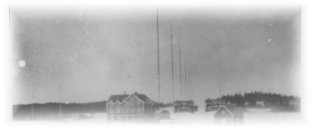Cherche Tous les Sites/Tous les Menus
Marconi at
Louisbourg Site
Trans-Atlantic Receiving Station
1913 - 1926

Marconi Website
Design and Content © by
Eric Krause, Krause House
Info-Research Solutions (© 1996)
All Images ©
Parks Canada Unless Otherwise Designated
Researching
the Fortress of Louisbourg National Historic Site of Canada
Recherche sur la Forteresse-de-Louisbourg Lieu historique national du Canada
Marconi at
Louisbourg Site
Trans-Atlantic Receiving Station
1913 - 1926

Timeline
|
* |
LOUISBOURG RECEIVING STATION HIGHLIGHTS |
|
1912
/ |
Transatlantic business had grown enough to warrant receiving stations being opened at Letterfrack, Ireland, and at Louisbourg, Nova Scotia and the duplex trans-Atlantic service began in 1913 |
|
1914
/ |
(1)The station,
with its staff of twenty-five, including censors, was considered to be an important military target, and was guarded by the 94th
Highlanders (2) Vacuum tubes were introduced into its receiving circuits, but cautiously at first, keeping the older crystal detectors and Brown available as back-ups at the flip of a switch (3) The receiver house was renovated and modified structurally to reflect these new arrangements |
|
1915 |
The CW system was used at Louisbourg in a successful experiment to receive CW signals from the U.S. naval radio station in Arlington, Virginia |
|
1916 |
Electric typewriter punches replaced the hand punch to produce perforated paper tapes |
|
1919 |
The first east-to-west transatlantic voice transmission was made from a Marconi station in Ballybunion, Ireland (using only three high powered vacuum tubes in the transmitter) to the Louisbourg receiving station |
1920 |
Staff of twenty-two at Louisbourg |
|
1926 / |
The long wave transatlantic service with its Cape Breton stations was now obsolete, and was closed (The closing of the Louisbourg station was hastened by a fire that destroyed the receiver building in 1927) |
|
Post 1926 / 1927 |
The residential buildings were dismantled and used for houses elsewhere |
| Post 1960 | The site of Louisbourg station is now a picnic area in the Fortress of Louisbourg National Historic Park |